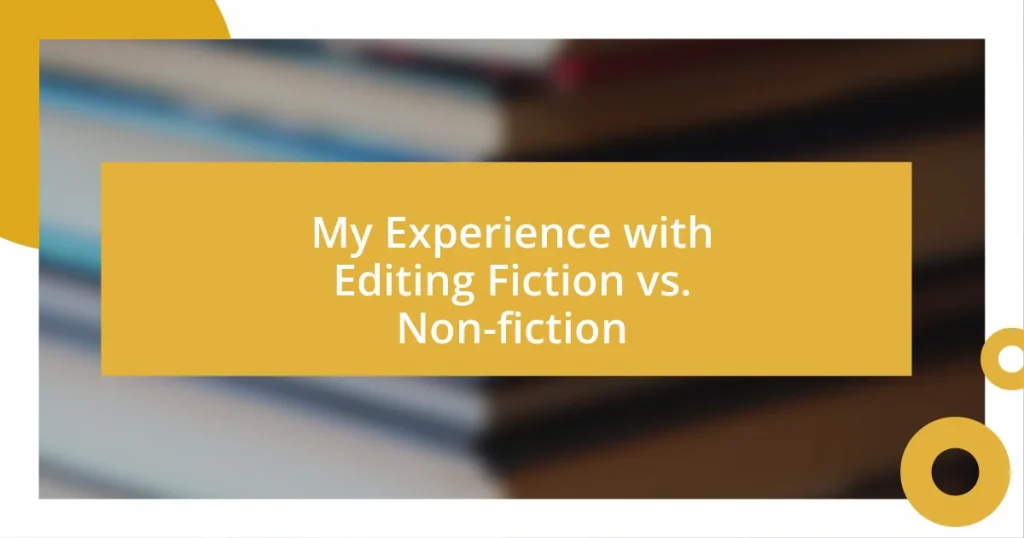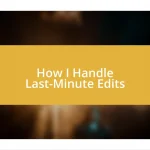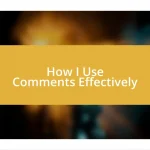Key takeaways:
- Fiction editing focuses on emotional resonance and character development, while non-fiction editing prioritizes accuracy and clarity.
- Editing involves collaborative tools and techniques to enhance narratives, ensuring an engaging experience for readers.
- Both genres require a balance between authorial voice and reader engagement, highlighting the importance of adaptability in the editing process.

Understanding Fiction and Non-fiction
Fiction and non-fiction serve very different purposes, but they both hold a special place in my heart. Fiction invites us into imagined worlds, where characters and plotlines can mirror reality or take us far beyond it. I remember the thrill of diving into a fictional manuscript, feeling the pulse of the characters’ emotions as if they were my own—doesn’t that feeling ignite a spark of creativity in all of us?
On the other hand, non-fiction is rooted in reality, grounding us with facts, truths, and real-life experiences. The first time I edited a memoir, I felt the weight of every word; it was like holding a piece of someone else’s life in my hands. How powerful is that? Non-fiction challenges us to reflect on our understanding of the world, shedding light on issues that might remain in the shadows otherwise.
As I edit these two genres, I’ve noticed a fundamental difference in tone and style, but the overarching goal remains the same: to connect with readers. With fiction, the emotions need to resonate, transporting the reader into the narrative’s universe. Meanwhile, with non-fiction, clarity and authenticity are essential. Have you ever considered how each genre speaks to a different aspect of our human experience?

Key Differences in Editing
When editing fiction, I often find myself immersed in the emotional landscape crafted by the author. It’s crucial for me to maintain the rhythm and flow of the narrative while honing in on character development and ensuring the plot remains engaging. I recall one time when I edited a fantasy novel; I really had to dive deep into the author’s imaginative world and consider how the characters’ emotions affect the overall story arc. It was a delicate dance, balancing the author’s voice while enhancing their vision.
In contrast, editing non-fiction demands a different approach. Here, accuracy and credibility are my guiding stars. I vividly remember editing an academic piece where each fact needed validation. It wasn’t just about word choice; it required me to verify every piece of information. The weight of responsibility felt heavy, but knowing that the final product could influence readers’ understanding made it fulfilling. There’s a unique satisfaction in shaping a narrative that relies on real-life truths rather than imagined ones.
The emotional stakes in fiction and non-fiction also differ significantly. With fiction, I’m crafting a journey to evoke empathy and emotional resonance. But with non-fiction, the aim is to educate and inform, often requiring me to maintain a neutral tone. I find that shifting between these two styles sharpens my editing skills, keeping me adaptable and aware of the nuances each genre demands.
| Aspect | Fiction Editing | Non-Fiction Editing |
|---|---|---|
| Focus | Character and plot development | Accuracy and clarity |
| Emotional Tone | Evocative and immersive | Informative and straightforward |
| Creativity | Encouraged and expansive | Rooted in facts |
| Reader Connection | Emotional resonance | Intellectual engagement |

The Editing Process for Fiction
When I embark on the editing process for fiction, it’s like stepping into a vivid, living tapestry of emotions and adventures. Each draft presents an opportunity not just to correct errors but to delve into the heart of the story. I remember editing a contemporary romance novel; it was so rewarding to enhance the chemistry between the main characters while ensuring their individual arcs were compelling. It’s a blend of nurturing the author’s voice while elevating the narrative—it’s like guiding a painter to refine their masterpiece while letting their brushstrokes shine through.
Here are some key steps I focus on during the editing phase for fiction:
- Character Development: I make sure every character has depth, goals, and growth by asking questions that reveal their motivations and connections.
- Plot Structure: I examine the pacing and ensure each scene contributes to the overall arc; this demands a balance between tension and release.
- Emotional Resonance: I look for passages that can be strengthened to evoke a deeper emotional response from readers; sometimes, a single line can transform a moment.
- World-Building: If the fiction includes a unique setting—like a dystopian world or a historical backdrop—I check for consistency and richness in detail, drawing the reader in.
- Dialogue Quality: Ensuring the dialogue sounds authentic is crucial; I often read it aloud to catch any awkward phrasing that might disrupt flow.
These elements are not merely tasks but part of a thoughtful curation process, allowing the piece to flourish. Each edit deepens my connection with the narrative, revealing layers of intent that leave me excited to share the finished work with others.

The Editing Process for Non-fiction
The editing process for non-fiction feels like unearthing a hidden treasure—each fact and argument needs refining to shine through clearly. On one project, I worked on a comprehensive health guide. I vividly remember poring over studies, cross-referencing sources, and realizing how vital each piece of information was for the reader’s understanding. Isn’t it fascinating how a single statistic can shift a reader’s perspective entirely? This responsibility drives me to ensure the accuracy of every claim.
As I edit, I often focus on clarity and structure. Recently, I tackled an environmental policy paper that zigzagged through various theories. It struck me how essential it was to construct a logical flow that guides readers seamlessly from one point to another. I questioned where the text might lose the reader, asking myself: Could a complex idea be simplified? Recognizing those areas not only enriches the narrative but also empowers the reader to grasp intricate concepts more easily.
Moreover, I’ve learned that tone plays a significant role in non-fiction editing. In one instance, I edited a memoir that struggled with a balance between personal narrative and factual events. Determining where to inject authenticity while maintaining a professional tone was a challenge. I often wonder: How do I keep the author’s voice without sacrificing objectivity? Ultimately, it’s about striking a delicate balance, ensuring the end result engages while educating. Each project leaves me more adept and appreciative of the diverse nuances that non-fiction requires.

Tools and Techniques for Editing
When it comes to editing, employing the right tools can be transformative. I remember using editing software like ProWritingAid on my last non-fiction project. This program not only highlighted grammatical errors but also suggested improvements in style and clarity. Having that little extra help made me feel more confident, allowing me to focus on refining the content rather than getting lost in the details. Have you ever tried a tool that changed your editing experience?
In fiction editing, I’ve often leaned on collaborative tools like Google Docs. It’s fantastic for real-time feedback; I can ask beta readers specific questions directly within the text. This way, I gather diverse perspectives that sometimes shine a light on aspects I might have missed. I find that the collective insight can drastically elevate the narrative, fostering a richer experience for the readers. What tools do you find indispensable in your editing routine?
On a more technical note, I always emphasize the importance of a style guide, especially when editing non-fiction. In editing a recent publication on sustainable living, I adhered to specific citation styles. Ensuring that facts were not only accurate but also consistently presented helped convey credibility and professionalism. I often think about how a well-maintained style guide not only organizes thoughts but also enhances readability. Doesn’t it feel rewarding when information flows seamlessly for the reader?

Common Challenges in Editing
Editing fiction presents its own unique challenges that often revolve around character development and narrative consistency. I recall a time when I edited a novel where a character’s motivations wavered, leading to a jarring experience for readers. It made me wonder: how can a character feel real if their actions don’t align with who they are? Bouncing ideas off the author helped me weave a stronger storyline that resonated emotionally, anchoring both the characters and the readers in their journey.
On the flip side, non-fiction editing can also be daunting when it comes to maintaining an objective perspective. I once worked on a travel guide where the author’s excitement inadvertently bled into over-the-top descriptions. It made me think about how vital it is to balance passion with professionalism. By suggesting a more grounded approach, I ensured the allure of the destination shone through without overshadowing factual information. Was I too directive, or did it enhance the guide? This reflective process fueled my appreciation for the fine line between engagement and accuracy.
There are definitely those moments when the editing process feels like unraveling a puzzle with pieces that don’t quite fit. I remember editing a biography that spanned decades; timelines were messy, and certain facts felt oddly placed. It was a bit like trying to navigate a maze without a map! I found that creating a visual timeline brought clarity, helping both me and the author see the narrative’s true shape. After all, isn’t it satisfying to watch a tangled story become streamlined? Transforming complexity into clarity is one of the most rewarding aspects of editing.

Personal Insights and Takeaways
Editing fiction and non-fiction has taught me invaluable lessons about storytelling and clarity. When I edited a short story collection, I noticed how essential it was to weave a consistent tone throughout. A small change in a single story could disrupt the entire collection’s flow. I found myself asking, how can a story resonate if it feels disjointed? Working closely with the author to maintain that cohesive voice was not just a challenge, but a rewarding journey of artistic collaboration.
Similarly, my experience with non-fiction editing revealed the power of audience awareness. I once tackled a memoir that was rich in detail but heavy on jargon. As I sifted through, I couldn’t help but ponder, who is this intended for? Simplifying the language while preserving the author’s voice felt like an intricate dance. It highlighted my belief that the best non-fiction doesn’t just inform; it connects on a personal level. I saw readers re-engage with the text, and that transformation was incredibly fulfilling.
Through these experiences, I’ve learned that editing goes beyond correcting grammar—it’s about shaping a narrative that resonates. I remember the thrill of refining a fiction piece where the protagonist’s internal struggle mirrored the author’s life journey. It wasn’t just about narrative arcs; it became a conversation between the writer and readers. Can a piece of writing evoke emotions? Absolutely. It’s these insights that deepen my appreciation for the editing process. Each edit is not just a change; it’s a chance to breathe life into words.















